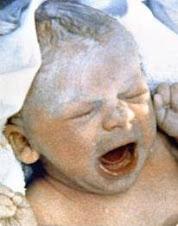SOURCE: http://news.bbc.co.uk/2/hi/health/4572377.stm
Fertility success gulf revealed
Fertility treatment success rates vary widely from clinic to clinic, according to the first comprehensive guide to be published on services in the UK.
The Human Fertilisation and Embryology Authority's publication on 85 clinics shows the average success rate for IVF for women under 35 to be just 27.6%.
But some centres achieve more than twice this rate.
HFEA chairwoman Suzi Leather said the guide aimed to help couples struggling to conceive to make informed choices.
She said many felt "left in the dark" about the treatment choices available to them at what could be a "difficult and emotional" time.
She said: "With one in seven people having some difficulty conceiving - almost 3.5m people across the UK - there is clearly a need for straightforward, independent information about infertility, its causes and the treatment options.
"Our guide is designed to cut through the jargon and complex science behind hi-tech fertility treatments to explain the causes of infertility, the possible treatments available and then give detailed information to let people make informed choices about the options available for them."
GPs lack information
Ms Leather said two out of five GPs had told the HFEA that they did not have enough information about fertility services.
"With treatment costing many thousands of pounds, it is right that the people paying for the treatment - the individual or the NHS - should get a proper sense of what they are paying for," she said.
The guide breaks down individual results according to the age of the women treated, showing success rates to be higher for younger women.
And Ms Leather pointed out that clinics specialising in treating younger women would be more likely to achieve high levels of success.
But she added that this alone could not account for the wide differences in success levels between clinics.
She told BBC News it was most likely that some clinics were simply "better" at delivering treatment, with more highly skilled embryologists.
Among the more successful clinics is London's Assisted Reproduction and Gynaecology Centre, which has a 59% success rate among women under 35 undergoing IVF using fresh eggs.
The guide reveals the most common age for women receiving IVF treatment to be 35.
It also indicates that 8,800 babies (1.5% of all births) are now born every year by IVF, 3,650 every year are born by intra-cytoplasmic sperm injection (ICSI), and many more thorough other assisted reproductive technology (ART).
The guide is available as an online, interactive version which allows patients to enter their details and receive tailored information about services and treatments in their area.
Infertility Network UK, a support group, said many people were still unable to access NHS treatment despite guidelines published last year which called for patients to be offered at least one full IVF cycle on the NHS.
Thus it was important that comprehensive information was available to help patients make the right choice for them.
Professor Alison Murdoch, of the British Fertility Society, said: "More and more couples are now coming to fertility clinics and many clinics take on couples who have really quite difficult fertility problems, which may be reflected in individual clinics' performance indicators.
"Infertility is a common medical condition, and the important challenge for the NHS now is to expand the level of fertility treatment available to those unable to have children through natural conception." Shadow Health
Secretary Andrew Lansley accused the government of ignoring guidelines to redress the restricted availability of fertility services.
HOW THE CLINICS FARED
IVF cycles resulting in live births
Clinic
NHS/Private
Live birth rates (%)
Assisted Reproduction and Gynaecology Centre, London
Both (NHS/Private)
58.5%
Woking Nuffield Hospital
Private
48.1 %
Centre for Assisted Reproduction, Gateshead
Both (NHS/Private)
43.4 %
Essex Fertility Centre, Buckhurst Hill
Private
39.5 %
UCH, London
Private
38.5%
Cromwell IVF and Fertility Centre, Swansea
Private
36.4%
Leicester Fertility Centre
Both (NHS/Private)
17.5 %
Cromwell IVF and Fertility Centre, London
Private
17.0 %
Brentwood Fertility Centre, Essex
Private
14.9%
Esperance Private Hospital, Eastbourne
Both (NHS/Private)
14.0%
St Mary's Hospital, Manchester
NHS
13.2 %
Willow Suite, Thames Valley Nuffield Hospital, Slough
Private
10.3 %
Source: HFEA (2005)
Friday, February 15, 2008
Subscribe to:
Post Comments (Atom)
| Powered By widgetmate.com | Sponsored By Digital Camera |







No comments:
Post a Comment